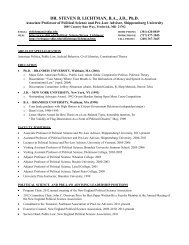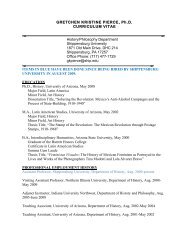Complete Issue - Shippensburg University
Complete Issue - Shippensburg University
Complete Issue - Shippensburg University
- No tags were found...
You also want an ePaper? Increase the reach of your titles
YUMPU automatically turns print PDFs into web optimized ePapers that Google loves.
10 PROTEUS: A Journal of IdeasMarika is making a bowl of grog, a lightly narcoticbeverage that is an anchor of traditional Fiji society.People with business to conduct sit wearing thetraditional Fijian skirt, and drink round after round ofgrog, served in half a coconut shell, as they discuss thematters at hand.Marika is using Fiji Water—the same Fiji Waterin the minibars of the Peninsula Hotel—becauseDrauniivi is one of the five rural villages near theFiji Water bottling plant where the plant’s workerslive. Drauniivi and Beverly Hills are part of the samebottled-water supply chain.Jim Siplon, an American who manages Fiji Water’sten-year-old bottling plant in Fiji, has arranged thegrog ceremony. “This is the soul of Fiji Water,” hesays. The ceremony lasts 45 minutes and goes throughfour rounds of grog, which tastes a little furry. Marikais interrupted twice by his cell phone, which he pullsfrom a pocket in his skirt. It is shift change at the plant,and Marika coordinates the minibus network thattransports villagers to and from work.Fiji Water is the product of these villages, a SouthPacific aquifer, and a state-of-the-art bottling plant in apart of Fiji even the locals consider remote. The plant,on the northeast coast of Fiji’s main island of Viti Levu,is a white two-story building that looks like a 1970s-erajunior high school. The entrance faces the interiorof Viti Levu and a cloud-shrouded ridge of volcanicmountains.Inside, the plant is in almost every way indistinguishablefrom Pellegrino’s plant in Italy, or PolandSpring’s in Hollis, filled with computer-controlledbottle-making and bottle-filling equipment. Linenumber two can spin out one million bottles of FijiWater a day, enough to load forty 20-foot shippingcontainers; the factory has three lines.The plant employs 200 islanders—set to increaseto 250 this year—most with just a sixth- or eighthgradeeducation. Even the entry-level jobs pay twicethe informal minimum wage. But these are more thansimply jobs—they are jobs in a modern factory, in aplace where there aren’t jobs of any sort beyond thevillages. And the jobs are just part of an ecosystememerging around the plant—water-based trickle-downeconomics, as it were.Siplon, a veteran telecom manager from MCI,wants Fiji Water to feel like a local company in Fiji.(It was purchased in 2004 by privately owned RollInternational, which also owns POM Wonderful andis one of the largest producers of nuts in the UnitedStates.) He uses a nearby company to print the carryinghandles for Fiji Water six-packs and buys engineeringservices and cardboard boxes on the island. By longstandingarrangement, the plant has seeded a smallbusiness in the villages that contracts with the plantto provide landscaping and security, and runs the bussystem that Marika helps manage.In 2007, Fiji Water will mark a milestone. “Eventhough you can drive for hours and hours on this islandpast cane fields,” says Siplon, “sometime this year,Fiji Water will eclipse sugarcane as the number-oneexport.” That is, the amount of sugar harvested andprocessed for export by some 40,000 seasonal sugarworkers will equal in dollar value the amount of waterbottled and shipped by 200 water bottlers.However we regard Fiji Water in the UnitedStates—essential accessory, harmless treat, or frivolousexcess—the closer you get to the source of its water, themore significant the enterprise looks.No, no coconut-fiber filtering, but rather, a toeholdin the global economy. Are 10,000 Fijians benefiting?Not directly. Perhaps 2,000. But Fiji Water is providingsomething else to a tiny nation of 850,000 people,which has been buffeted by two coups in seven years,and the collapse of its gold-mining and textilesindustries: inspiration, a vision of what the countrymight have to offer the rest of the world. Developedcountries are keen for myriad variations on just whatFiji Water is—a pure, unadulterated, organic, andnatural product. Fiji has whole vistas of untouched,organic-ready farmland. Indeed, the hottest topic thisspring (beyond politics) was how to jump-start anorganic-sugar industry.Of course, the irony of shipping a precious productfrom a country without reliable water service is hardto avoid. This spring, typhoid from contaminateddrinking water swept one of Fiji’s islands, sickeningdozens of villagers and killing at least one. Fiji Wateroften quietly supplies emergency drinking water insuch cases. The reality is, if Fiji Water weren’t tappingits aquifer, the underground water would slide intothe Pacific Ocean, somewhere just off the coast. Butthe corresponding reality is, someone else—the Fijiangovernment, an NGO—could be tapping that supplyand sending it through a pipe to villagers who needit. Fiji Water has, in fact, done just that, to somedegree—20 water projects in the five nearby villages.Indeed, Roll has reinvested every dollar of profit since2004 back into the business and the island.Siplon acknowledges the risk of slipping intocapitalistic neo-colonialism. “Does the world need FijiWater?” he asks. “I’m not sure I agree with the critics onthat. This company has the potential of delivering greatvalue—or the results a cynic might have expected.”Water is, in fact, often the perfect beverage—healthy, refreshing, and satisfying in a way soda or juicearen’t. A good choice.Nestlé Waters’ Kim Jeffery may be defending hisindustry when he calls bottled water “a force of nature,”but he’s also not wrong. Our consumption of bottledwater has outstripped any marketer’s dreams or talent:If you break out the single-serve plastic bottle as itsown category, our consumption of bottled water grew athousandfold between 1984 and 2005.
















